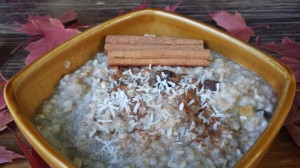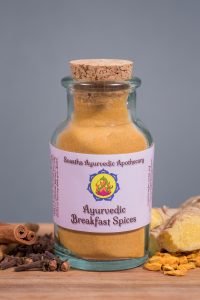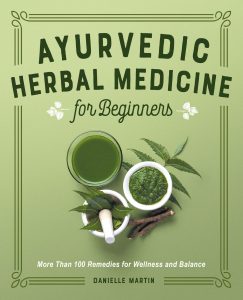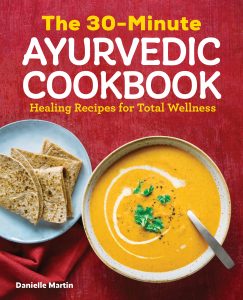 Ojas is the biological energy that is responsible for your energy, vitality, longevity, immunity, softness, and glow. During the fall and winter seasons, Vata tends to increase, depleting Ojas in the body, leaving you fatigued, unmotivated, dried out, and prone to sickness. Low Ojas can also lead to a restless mind, lack of grounding, sleep issues, and low libido. If you are experiencing feelings of depletion or restlessness, this nourishing recipe is a great way to regain your strength and vitality, and ground your energy throughout the fall and winter seasons.
Ojas is the biological energy that is responsible for your energy, vitality, longevity, immunity, softness, and glow. During the fall and winter seasons, Vata tends to increase, depleting Ojas in the body, leaving you fatigued, unmotivated, dried out, and prone to sickness. Low Ojas can also lead to a restless mind, lack of grounding, sleep issues, and low libido. If you are experiencing feelings of depletion or restlessness, this nourishing recipe is a great way to regain your strength and vitality, and ground your energy throughout the fall and winter seasons.
Read more on “How to Increase Ojas”.
This breakfast recipe is nourishing, sustaining, and perfect for a cold morning. It will truly calm your nervous system and soothe your soul. Besides increasing your energy, immunity, and vitality, this nutritious recipe is packed with vitamins, antioxidants, and phytonutrients. Ojas Oatmeal is high in fiber, protein, healthy fats, iron, zinc, magnesium, manganese, and copper. Wholegrain oats are well known for reducing inflammation, lowering cholesterol levels, reducing your risk for heart disease, balancing blood sugar levels, and reducing your risk for obesity.
Ojas-Increasing Oatmeal Recipe
Click here for a printable copy of this recipe.
- Doshic effect: Vata ↓,Pitta ↓, Kapha ↑*
- Vegetarian (can be made Vegan)
- Serving: 2 to 3
- Time: 35 minutes
*See doshic variations at the bottom of the page to make this recipe more Kapha-friendly!
Materials
- Medium saucepan
- Spoon for mixing
- Measuring cups
Ingredients
- 2 cups water
- 1¼ cups almond milk (or milk of choice)
- 1 cup steel-cut oats
- 1/8 teaspoon salt
- 20 raisins
- 2 Medjool dates, pitted and chopped
- 2 tablespoons shredded coconut
- 1 to 2 teaspoons Ayurvedic Breakfast Spices*
- ½ to 1 teaspoon cinnamon
- 1 teaspoon vanilla extract
- 2 teaspoons ghee
- 1 to 2 tablespoons honey (optional, use maple syrup for Pitta)
- Dash cinnamon, for garnish
- Coconut, for garnish
*Ayurvedic Breakfast Spices can be replaced with 1 teaspoon of cinnamon, ½ teaspoon ginger powder, ¼ teaspoon cardamom powder, and ⅛ teaspoon turmeric.
Directions
Click here for a printable copy of this recipe.
1. Place the water and almond milk into a medium saucepan. Bring the water to a boil and then reduce the heat to a low-medium setting.
2. Add in the steel cut oats and salt. Cook the oats covered for 20 minutes over low-medium heat. The lid may need to be cracked to avoid overflow. Stir every 7 to 10 minutes.
3. Turn the heat off but keep the pan on the hot burner. Add in the raisins, dates, coconut, Ayurvedic Breakfast Spices, cinnamon, vanilla, and ghee. Stir until everything is evenly mixed. Cover the pan for 5 minutes to allow the oats to soften.
4. Serve into bowls. Once the oats have cooled slightly, add in 1 to 3 teaspoons of honey* (if used), a dash of cinnamon, and a sprinkle of the coconut onto each serving.
5. Sit, eat, enjoy, and energize.
6. Store leftovers in an airtight container for 2 to 5 days.
*Honey should never be heated or cooked over 108 degrees as it will become toxic to the system (read more on why here).
Reheating tip
Double this recipe for your workweek! Leftovers are not always recommended in Ayurveda, but a reheated bowl of homemade oatmeal will likely be healthier than a piece of toast or bowl of cold cereal and milk. To reheat, place the amount desired in a pan, stir in ½ cup of milk or milk alternative, and set the heat to low. Cook for 5 to 10 minutes stirring frequently. Adding in some fresh cinnamon and ghee will help to liven up the flavor.
Optional Doshic Variations
VATA
This recipe is great for Vata types and during Vata imbalances; no changes are needed!
For extra nourishment and protein, you can stir in one to two eggs during the last three to five minutes of the cooking process.
PITTA
To make this recipe even better for Pitta types, use maple syrup instead of honey. Otherwise, this recipe is naturally Pitta-reducing and can be left as is.
For extra nourishment and protein, you can stir in 2 to 4 egg whites egg during the last three to five minutes of the cooking process.
KAPHA
Kapha types will want to use buckwheat groats instead of the steel cut oats (same proportions). They can eliminate the dates, and replace the shredded coconut with 1 tablespoon of freshly ground flaxseed. The amount of ghee can be reduced to ½ teaspoon. The spices can be increased to help aid in digestion and add a bit of lightness to the meal. For times of congestion or heaviness, the almond milk can be replaced with equal amounts of water.
Try my Ayurvedic Breakfast Spices!
Discover more healing recipes with my 30-Minute Ayurvedic Cookbook!






How can I print this recipe from this page?
Hi Goldie! Thank you so much for your interest. I have sent you a pdf copy of this recipe to your email account that you have provided. Please let me know if you have any further questions. Thank you again! Namaste, Danielle
[…] Ojas Increasing Oatmeal This takes a little while to cook, but it’s worth it, especially when it’s cold outside. I add walnuts at the end. And I mixed the right amounts of those spices (cinnamon, turmeric, cardamom, ginger, clove) in a little jar so I can just take half a teaspoon of that mix and stir it in to save time. […]
I thought it was an Ayurvedic no-no to combine fruits with other foods…
Hi Frasier! Thank you for your comment. I actually get asked this question often, so I am sure others out there are also wondering. Fruit is definitely meant to be eaten on its own, as it is one of the main food combining rules in Ayurveda. However, raisins and dates cooked into a meal, is considered an exception to this rule. So now you are probably left wondering why? I know I had this same question during my schooling. Unfortunately, not everything has a definitive answer. There is actually a Sanskrit word for this called “Prabhav”, meaning a special quality or action a substance possesses. Often these special actions are left unexplained. And as one of the many famous quotes from Dr. Lad, “it is so”. So this is the best answer I can provide for you.
Of course, I have come across individuals with extremely sensitive digestion, and they felt better not adding even raisins or dates to their meals. So if for any reason, you feel like it is not beneficial for you to mix these substances in one meal, then by all means listen to your body!
Thanks again for your inquiry!
Namaste,
Danielle
Great response!
I’ve read that honey is not good for Vata, because of its astringent properties.
Hi Isabela,
Thank you for your question. It is true that honey does have a slight astringent property to it which can lead to dryness and therefore Vata aggravation. However, it is still considered acceptable for Vata types in moderate amounts due to its more potent sweet taste and heating energy. Out of all the doshas it is best for Kapha types and generally not recommended for Pitta (especially if there is already too much heat). I hope this helps!
Namaste,
Danielle
I need an explanation regarding the use of Vanilla extract as I’m sure it wasn’t available during Vedic times and while I can’t remember the source (it would have been either from Dr. Lad, Maharishi Ayurveda or Banyan Botanicals) I remember reading that Vanilla extract was not an acceptable spice and therefore I am assuming it would not be appropriate or Sattvic after a cleanse.
That being said, with a suitable explanation I would happily use it as I love it!
I appreciate greatly the information, recipes and recommendations on the Rejuvenation phase of an Ayurvedic Gentle Cleanse especially since there’s so little information available.
Hi Lynn,
Thank you for your question! I personally have not been taught that vanilla extract is not an acceptable spice. I would have to hear the reasoning behind it to speak any further. In my studies at the Ayurvedic Institute with Dr Lad, I was taught that vanilla is sweet (and slightly astringent), cooling, and is balancing for all three doshas. It is an aromatic spice which means it acts on calming the mind and grounding the energy.
My guess for this theory would be due to the alcohol base, which of course is quite heating and penetrating. However, the alcohol cooks out with hot temperatures and even evaporates at room temperature when it is left out in the open air for over 30 minutes. In cooking, we are also using such a small amount, even if any of the alcohol were to remain, I would be very surprised to hear it having any noticeable effects.
If you are still wanting to stay away from the extract, but are craving a bit of vanilla flavor in your recipes, I would highly recommend to purchase the vanilla bean in its whole form. In fact, the whole bean is incomparable (in taste and in quality) to the extract, and if it were more affordable, I would only use the bean myself. For this recipe you can mince up an inch of the bean, and add it in at the same time as the extract.
I hope this helps a bit! Since with Ayurveda there are always going to be conflicting theories on many topics, sometimes it is best to collect the knowledge and figure out what makes the most sense for you.
Thank you again for bringing this question to light! Many blessing:)
Namaste,
Danielle
Is it all right to use A2 grassfed milk instead of water?
Hi Mat,
Thank you for your question! Yes, you can use milk instead of water in this recipe, as milk is very good for Ojas as well. Just make sure to monitor the cooking process closely since milk can burn easily at the bottom of the pan. You may need to increase the frequency of stirring because of this.
Please note that it is not recommended to use milk if you are experiencing a coated tongue or any other signs of toxins. Adding milk will be beneficial for most Vata and Pitta types (as long as you can digest dairy), but is not recommended for Kapha types.
I hope this helps!
Namaste,
Danielle
Hi Danielle,
I thought protein (eggs) and starches are not to be combined?
Is it ok to even use animal protein when your dosha’s are not in balance? I’m Pitta/Vata.
Ayurveda is new to me.
Greetings,
Lara
Hi Lara,
Thank you for the great questions! You are correct that generally speaking, it is best not to eat animal protein with high starch foods such as grains. Although I feel this is an important rule overall, I have found that adding eggs to my porridges (oats, buckwheat, quinoa, millet, etc) does not affect my digestion negatively and the benefits of getting more protein in the mornings (while still enjoying my porridge) make it a great meal option for me.
I have a sensitive digestion that is not afraid to tell me when something is not agreeable for me. However, we all have unique gut floras, digestive types, allergies, and imbalances so if you decide to try adding eggs to your oats and feel gassy, bloated, heavy, sleepy, acidic, or whatever after, then it is not a good meal choice for you.
There are a lot of rules in Ayurveda, so it is best to use them as guidelines but ultimately, do what works best for your body (and mind).
I hope this helps! Let me know if you have any further questions and I will be happy to help.
Take it slow and be well:)
Namaste,
Danielle